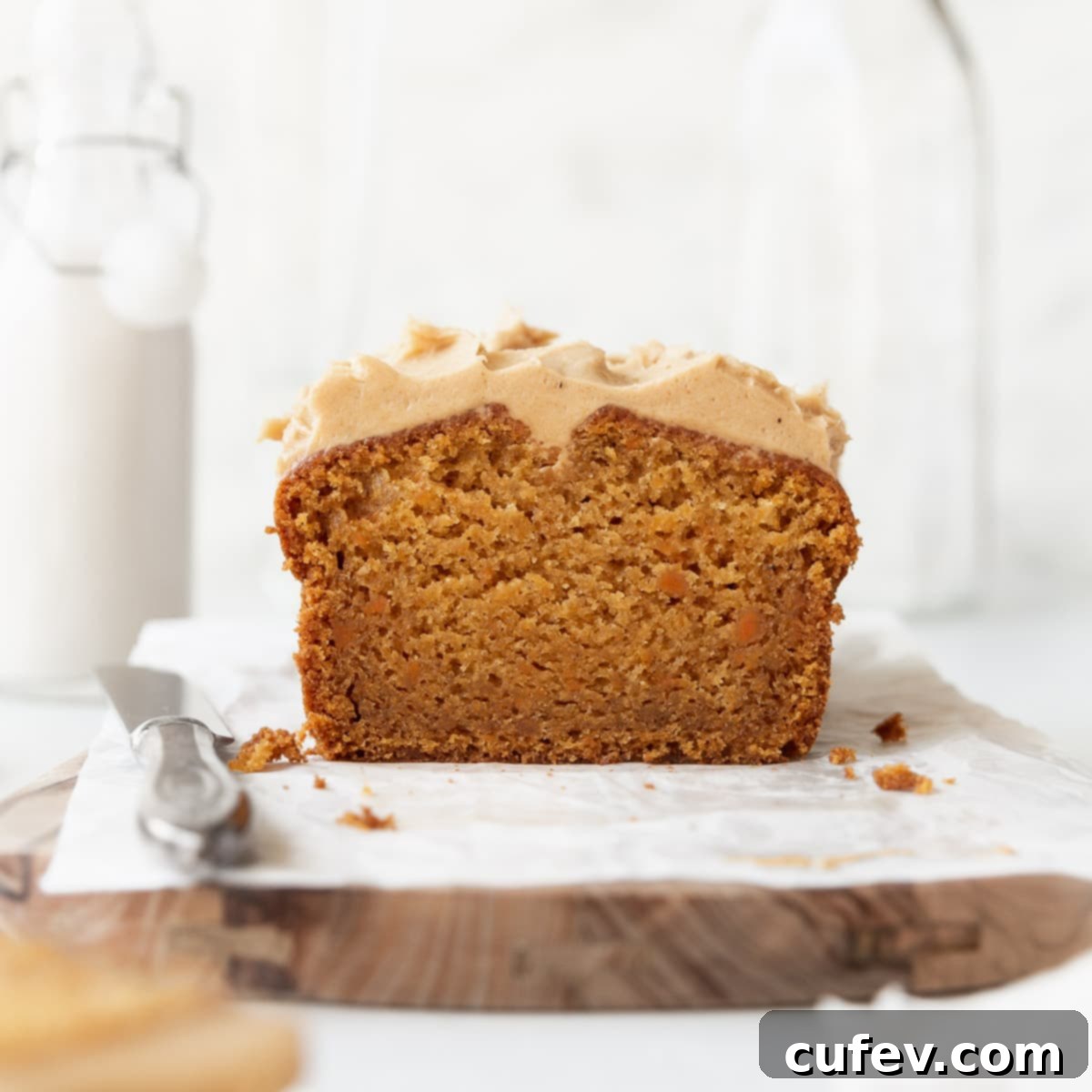Delicious Sweet Potato Cake with Maple Cashew Frosting (Gluten-Free & Dairy-Free Option)
Prepare to elevate your autumn baking with this irresistible Sweet Potato Cake! This fan-favorite fall dessert masterfully combines the cozy warmth of seasonal spices, the natural sweetness of roasted sweet potato, and a truly decadent, creamy maple cashew frosting. It’s not just a delight for your taste buds; this cake is also incredibly versatile, easily made gluten-free and naturally dairy-free, ensuring everyone can enjoy a slice. Just one forkful and you’ll discover a new staple for your fall recipe collection, forever changing your perception of seasonal treats!
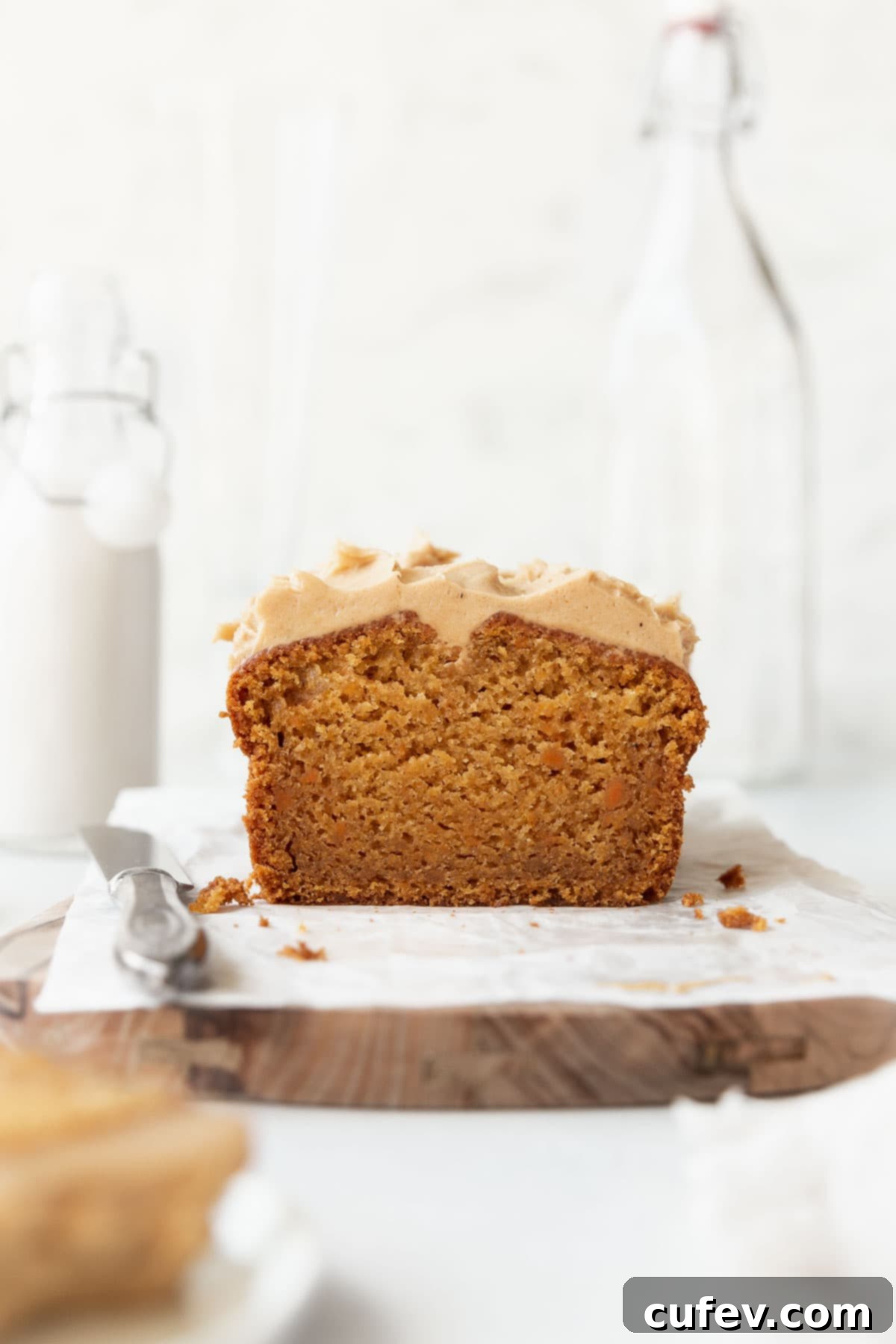
This beloved recipe was originally introduced on October 4, 2019, quickly gaining popularity for its unique blend of flavors. We’ve recently refreshed it with stunning new photographs and updated information on June 17, 2023, to make your baking experience even better.
While the arrival of fall often brings a flurry of pumpkin spice enthusiasm, I find myself equally, if not more, excited about the humble sweet potato! All through the summer months, I eagerly anticipate the season when sweet potatoes are at their peak, perfect for roasting and transforming into glorious desserts. There’s something inherently comforting and deeply satisfying about their earthy sweetness that makes them an ideal star for autumn baking.
For the foundation of these wonderfully moist sweet potato cake layers, I drew inspiration from my tried-and-true pumpkin bread recipe. It’s a personal favorite quick bread, second only to my incredibly moist banana bread! After carefully adapting it to highlight the sweet potato, I infused the batter with a harmonious blend of warm, inviting spices. The grand finale? A sumptuous, rich vegan maple cashew frosting that truly sets this cake apart.
This unique frosting, a star in its own right, boasts a base of creamy cashew butter and refined coconut oil. It’s naturally sweetened with pure maple syrup, completely bypassing the need for traditional powdered sugar. This creates a frosting that is not only healthier but also offers a distinct caramel-like depth of flavor. Due to its natural composition, this frosting is softer than conventional buttercream and will melt faster at room temperature. For this reason, it’s essential to store the frosted cake in the refrigerator. Trust me, the exquisite taste and smooth texture are absolutely worth this small extra step!

Why This Sweet Potato Cake Recipe Will Become Your New Fall Favorite
Boasting consistent 5-star reviews, this sweet potato cake recipe has truly earned its place as a cherished household favorite. Here are just a few compelling reasons why it’s so adored and why you’ll love baking it:
- Perfect for Bakers of All Levels. Whether you’re a seasoned pro or just beginning your baking journey, this sweet potato cake recipe is incredibly approachable. There are no overly complicated techniques or intimidating steps involved. The cake layers come together with ease, and the frosting, despite its luxurious taste, is simple to prepare and spread. It’s an ideal project for new bakers looking to create something truly impressive without the stress.
- Effortlessly Beautiful & Impressive. If you’re searching for a dessert that looks as stunning as it tastes, your search ends here! This sweet potato cake, with its rustic charm and elegant frosting, presents beautifully on any table. It’s the kind of dessert that commands attention and elicits compliments, making it perfect for holiday gatherings, dinner parties, or simply a special weekend treat. Despite its gorgeous appearance, it’s surprisingly simple to achieve, giving you a show-stopping result with minimal fuss.
- Thoughtfully Allergy-Friendly. For all my friends navigating food allergies, this recipe is a true gift! This delightful layered sweet potato cake is naturally dairy-free, making it a fantastic option for those avoiding milk products. Furthermore, it’s exceptionally easy to convert to a gluten-free sweet potato cake. Simply use a high-quality 1-to-1 gluten-free flour blend, and you’ll achieve the same tender crumb and wonderful flavor. It’s a dessert designed to be inclusive, allowing more people to enjoy a delicious, homemade treat.
- Embraces Distinctive Fall Flavors. While pumpkin spice certainly has its moment, this sweet potato cake offers a refreshing and equally comforting alternative. It showcases the rich, warm, and subtly nutty flavors that define the fall season. With a bespoke blend of spices that perfectly complement the sweet potato, this cake sings of autumn in a unique and memorable way. It’s a wonderful option for those seeking something different, or simply adding more variety, to their seasonal dessert repertoire.
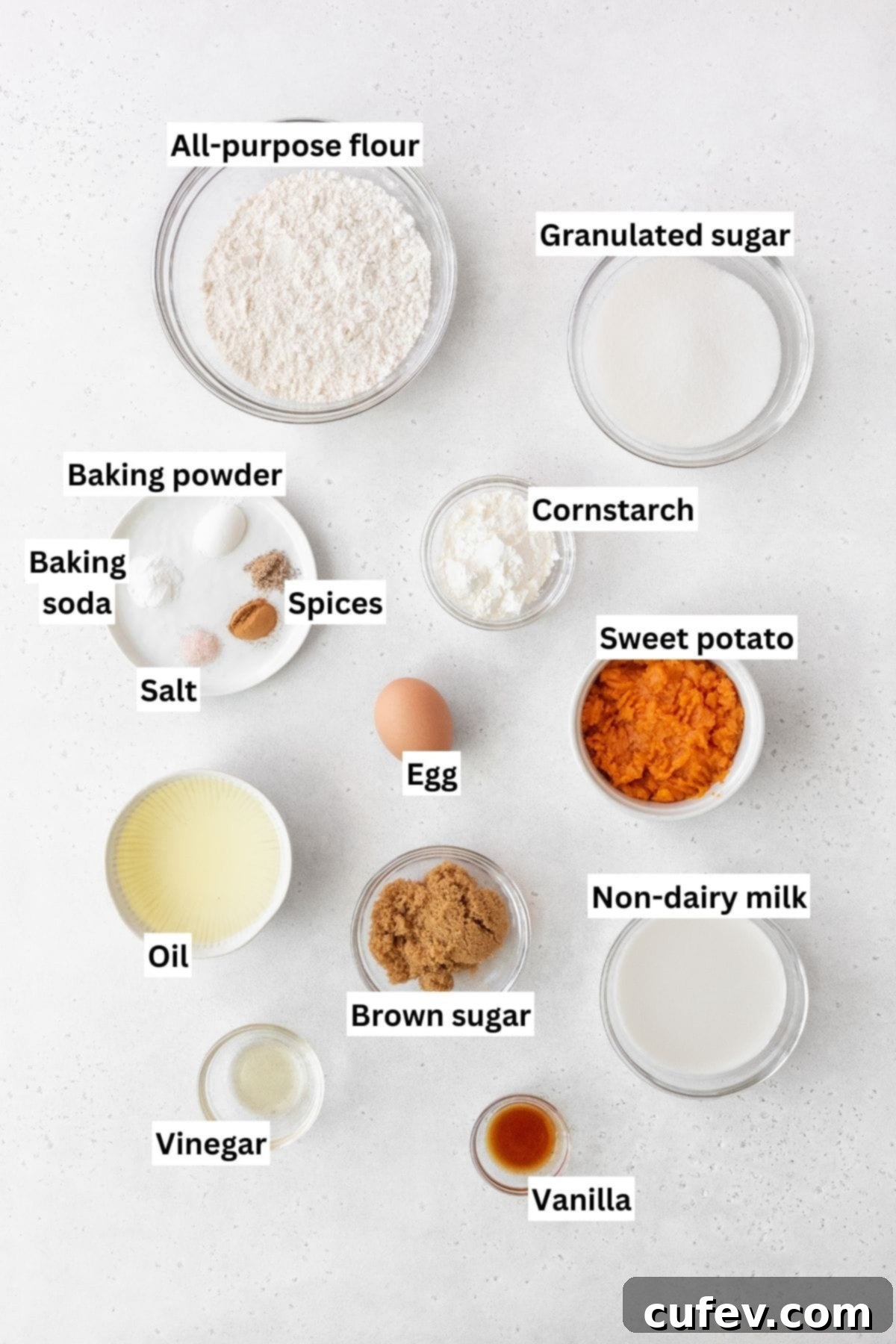
Essential Sweet Potato Cake Ingredients
Each ingredient in this sweet potato cake recipe plays a crucial role in achieving its perfect texture and rich flavor. Here’s a breakdown of what you’ll need and why:
- Sweet Potato Purée – The star of our show! For the best results, opt for sweet potato varieties that are naturally more moist and less starchy, such as a classic orange sweet potato or a yam (which is often marketed as sweet potato in the US). Avoid using Japanese sweet potatoes, as their starchier texture can lead to a drier, less desirable cake consistency. Canned sweet potato puree can be used for convenience, but for an exceptional depth of flavor, I highly recommend making your own roasted sweet potato puree.
- Flour – My top recommendation for this recipe is a gluten-free measure-for-measure flour blend. These blends are specifically designed to be substituted 1:1 for traditional all-purpose flour, making the recipe easy to adapt for gluten-free diets. If gluten isn’t a concern for you, standard all-purpose flour or cake flour will also yield excellent results, providing a tender crumb.
- Brown Sugar – This isn’t just for sweetness! Brown sugar contributes a wonderful, deep molasses flavor and a subtle toffee-like note that perfectly complements the sweet potato and warm spices. It also adds moisture, helping to keep the cake wonderfully soft.
- Granulated Sugar – Paired with brown sugar, white granulated sugar provides the foundational sweetness to the cake. It ensures the cake is adequately sweet without becoming cloying, allowing the natural flavors of the sweet potato and spices to shine through.
- Large Egg – The essential binder! The egg helps to bring all the ingredients together, providing structure to the cake batter. It also aids in even rising, contributing to the light and airy texture of the finished cake.
- Oil – A neutral-flavored oil (like avocado, grapeseed, or light olive oil) is crucial for adding moisture and tenderness to the cake without imparting any overpowering flavors. It helps create that desirable moist crumb that we all love in a good cake.
- Non-Dairy Milk – For a naturally dairy-free cake, unsweetened almond milk is my preferred choice due to its neutral flavor profile. However, vanilla-flavored dairy-free milk can also be used if you prefer a hint of vanilla, or you can opt for other nut milks like cashew or soy milk. If dairy is not an issue, regular whole milk works perfectly fine.
- Spices – This cake features a custom blend of warm, aromatic spices that elevates it beyond the ordinary. Cinnamon provides a classic sweetness, nutmeg adds a hint of pungent warmth, ground cloves contribute a rich, slightly peppery note, and allspice brings a complex blend of clove, nutmeg, and cinnamon flavors. A touch of fresh orange zest (optional but highly recommended!) brightens the entire profile with its citrusy aroma.
- Baking Soda & Baking Powder – These are our leavening agents, working in harmony to give the cake its lift and tender crumb. Baking soda reacts with acidic ingredients (like brown sugar and sweet potato) to create carbon dioxide, while baking powder provides an additional boost, ensuring the cake rises beautifully and evenly.
- Salt – A pinch of fine salt is vital in baking! It doesn’t just add its own flavor; it balances and accentuates the sweetness of the cake, making all the other flavors more pronounced and vibrant.
Additional Cashew Frosting Ingredients
The maple cashew frosting is a creamy, dreamy complement to the sweet potato cake. Here’s what you’ll need to create this luscious, dairy-free topping:
- Cashew Butter – This is the creamy backbone of our frosting, providing a rich, nutty flavor and a smooth texture. You can typically find cashew butter in most major grocery stores, often in the peanut butter aisle or in the health food section. For the best consistency, opt for a smooth, natural cashew butter.
- Refined Coconut Oil – Unlike virgin coconut oil, refined coconut oil undergoes additional processing to remove its distinct coconut flavor and aroma. This is key for our frosting, as it allows the other delicious flavors of maple and cashew to truly shine without any tropical interference. It also helps the frosting set nicely when chilled.
- Coconut Cream – Not to be confused with lighter coconut milk, coconut cream is much thicker and richer. It adds an incredible depth, luxurious mouthfeel, and velvety texture to the frosting, making it wonderfully decadent. Look for full-fat coconut cream in cans, often found near other Asian ingredients or baking aisles.
- Maple Syrup – Our natural sweetener of choice! Pure maple syrup contributes a complex, caramel-like sweetness that beautifully complements the cashew butter. It’s a healthier alternative to refined sugars and imparts a uniquely comforting fall flavor.
- Vanilla Extract – A touch of vanilla enhances all the other flavors, adding warmth and depth to the frosting, making it even more irresistible.
- Fine Sea Salt – Just a tiny pinch of salt in the frosting helps to balance the sweetness of the maple syrup and brings out the nutty notes of the cashew butter, creating a perfectly harmonious flavor profile.
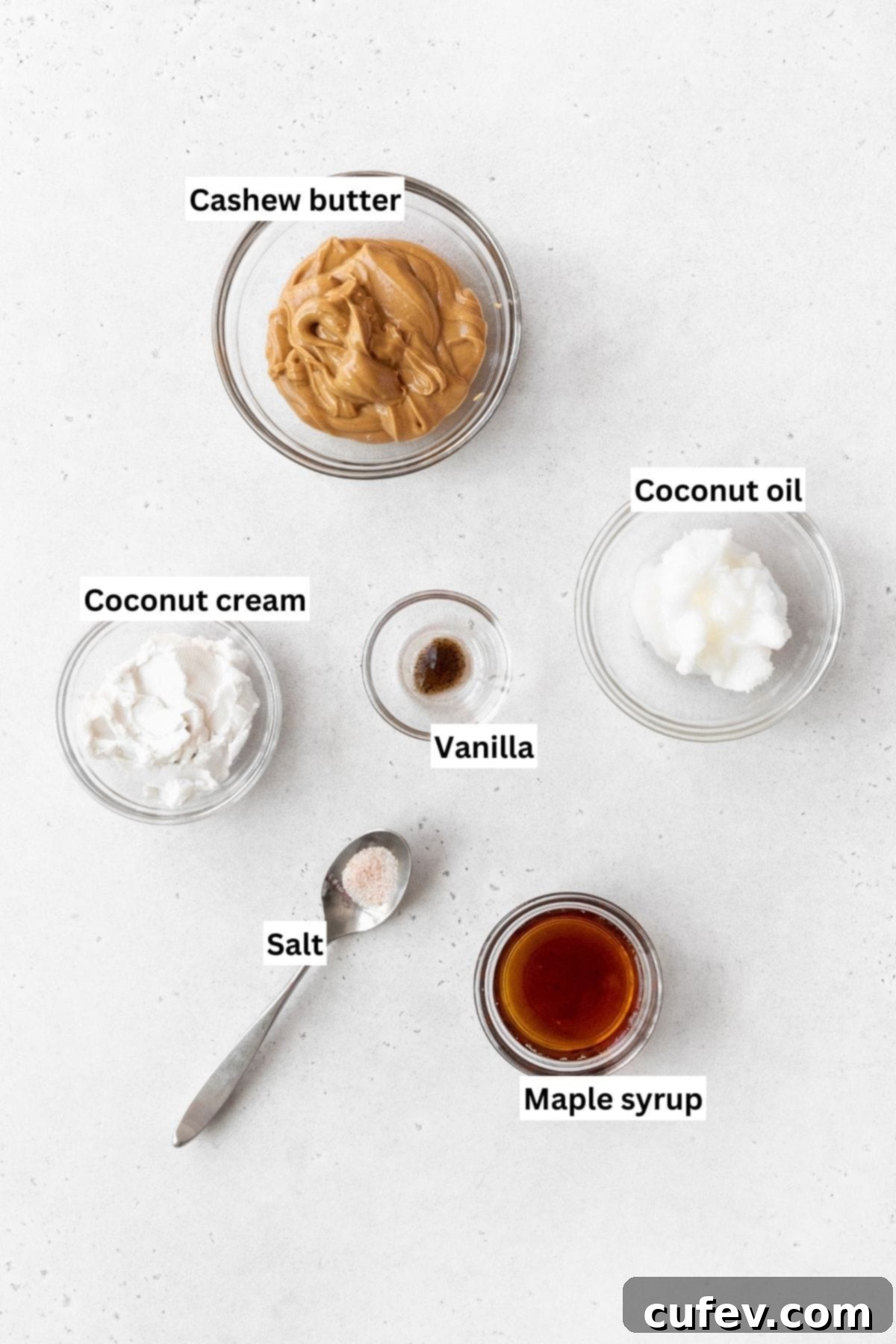
Approved Ingredient Substitutions for Sweet Potato Cake
While I always recommend following the recipe precisely for the absolute best results, I understand that sometimes you might need to make a tweak or two. Here are a few approved substitutions that won’t drastically compromise the quality of your delicious sweet potato cake:
- Squash Alternatives for Sweet Potato Purée: If sweet potatoes aren’t readily available or you simply want to experiment, roasted and puréed butternut squash or sweet baking pumpkin can serve as excellent substitutes. These provide a similar creamy texture and subtle sweetness. Do keep in mind that the flavor profile of your cake will shift slightly, and the texture might be a touch denser, but the overall result will still be wonderfully flavorful and a fantastic fall treat.
- Oil Options: My personal preference for this recipe is avocado oil, due to its neutral flavor and healthy fat content. However, if you don’t have it on hand, you can successfully use other neutral-flavored oils. Good alternatives include light olive oil (ensure it’s *not* extra virgin, which has a stronger flavor), grapeseed oil, or sunflower oil. The key is to choose an oil that won’t compete with the delicate flavors of the sweet potato and spices.
- Milk Choices: This recipe calls for non-dairy milk to keep it naturally dairy-free. Unsweetened almond milk is my go-to, but feel free to use other nut milks like cashew milk or soy milk, which will work beautifully. If you don’t have dietary restrictions or are looking for a richer flavor, regular whole milk can also be used interchangeably without any issues. The slight increase in fat from whole milk can even contribute to a slightly more tender cake.
How to Bake the Perfect Sweet Potato Cake
Despite its stunning appearance, don’t let this sweet potato cake intimidate you! It’s surprisingly straightforward to make. Follow these simple steps for a truly rewarding baking experience:
Step 1: Prepare Your Baking Environment. Begin by preheating your oven to 350°F (175°C). Next, take an 8-inch loaf pan and lightly grease it, then line it with parchment paper, allowing some overhang on the sides. This parchment “sling” will make it incredibly easy to lift the baked cake out of the pan later. Set your prepared pan aside.
Step 2: Combine Dry Ingredients. In a large bowl, whisk together all your dry ingredients: the flour (whether all-purpose or gluten-free measure-for-measure), salt, baking soda, baking powder, and all your warm spices (cinnamon, nutmeg, ground cloves, allspice). If you’re using fresh orange zest, add it to this mixture now. Whisk thoroughly until all ingredients are well combined and there are no visible lumps. This ensures even distribution of the leavening agents and spices throughout the batter.
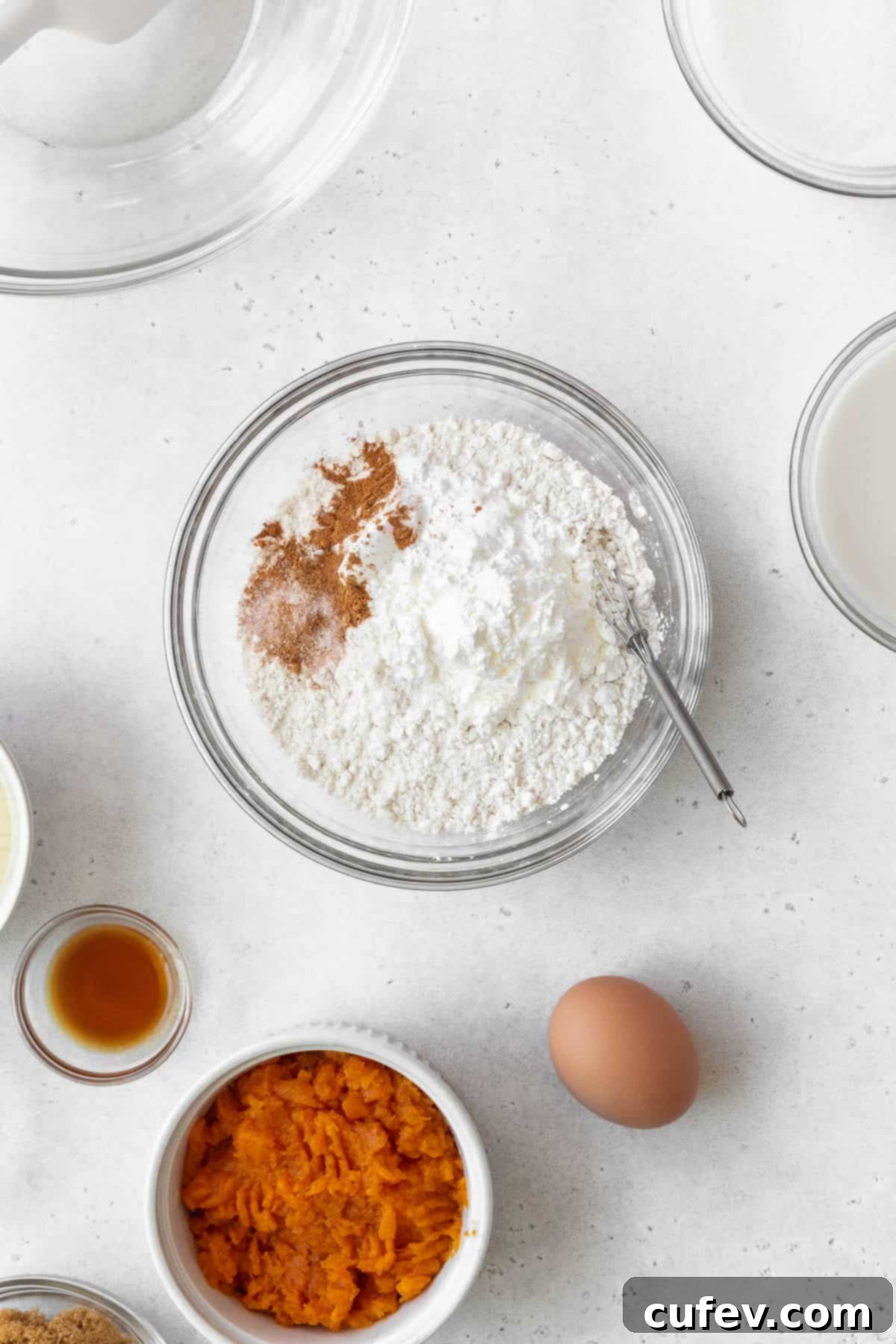
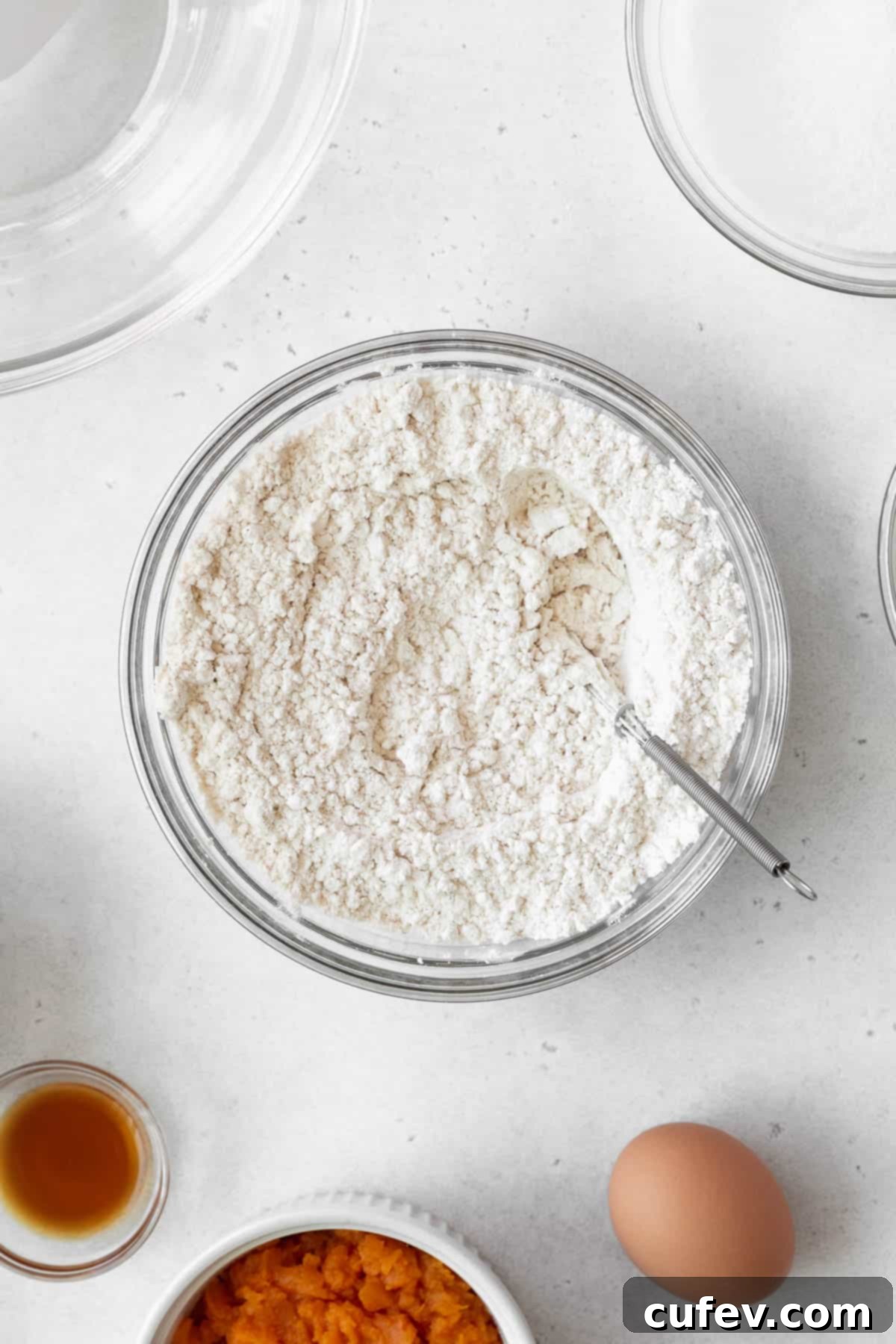
Step 3: Prepare Wet Ingredients. In a separate, large bowl, begin by whisking together the neutral-flavored oil, granulated sugar, and brown sugar. Pay extra attention to the brown sugar, ensuring you break up any hard clumps to achieve a smooth, uniform mixture. Once the sugars and oil are well combined, whisk in the large egg until fully incorporated. Then, add the sweet potato purée, vanilla extract, and your chosen non-dairy milk. Whisk everything together thoroughly until the mixture is smooth and harmonious.

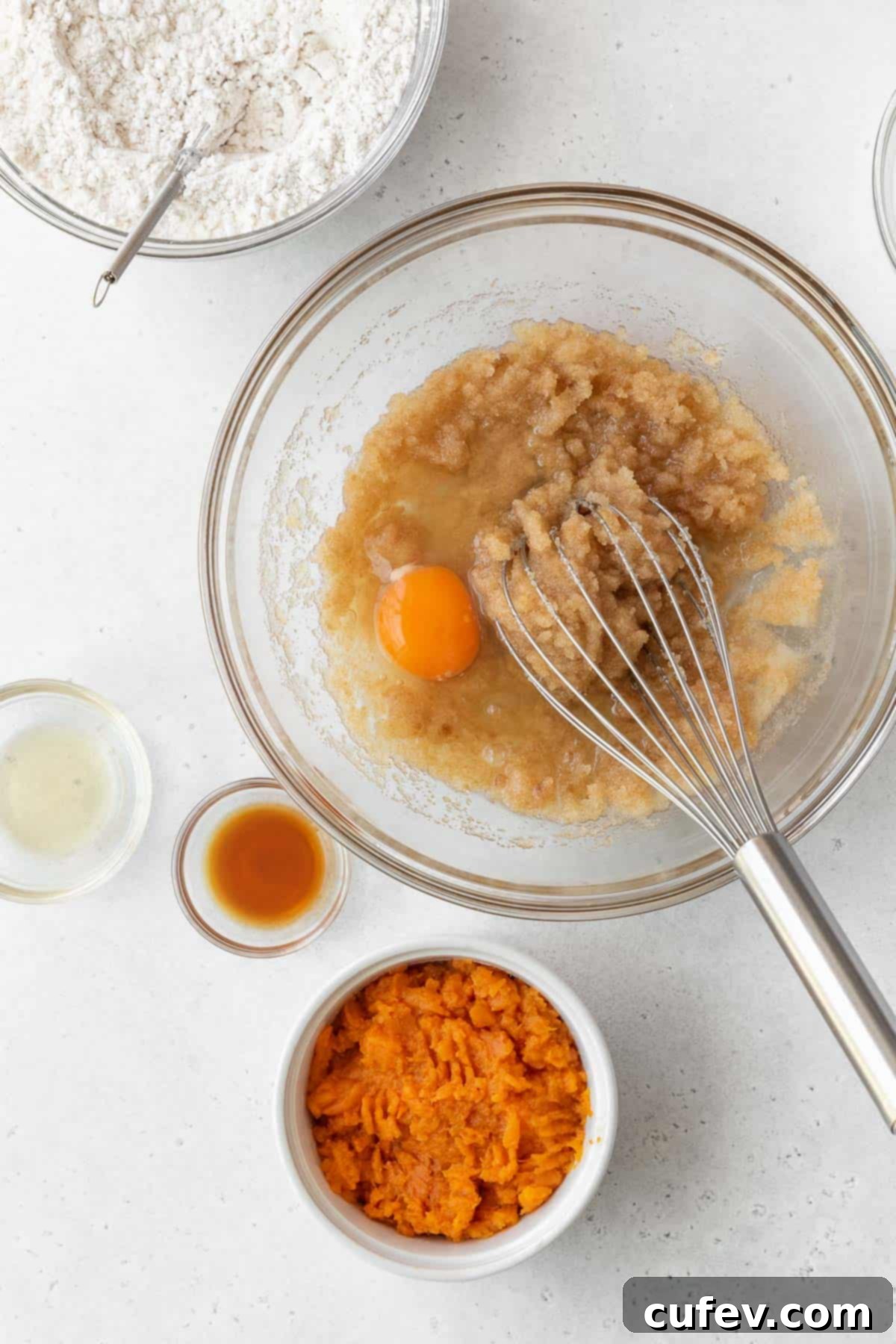

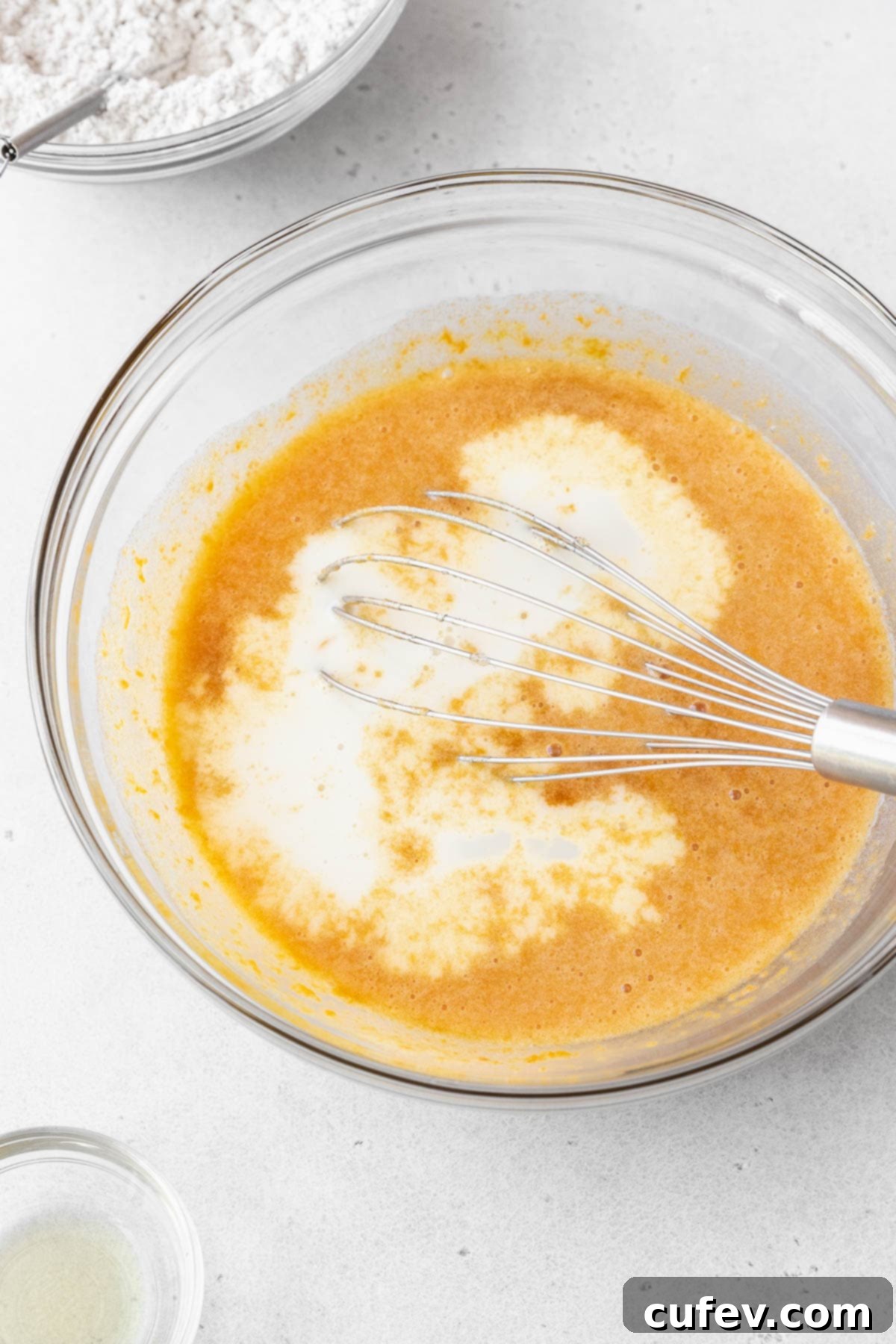
Step 4: Combine Wet and Dry Ingredients. Pour the dry ingredients mixture into the wet ingredients bowl. Using a spatula or whisk, stir gently until the ingredients are just combined. Be careful not to overmix; overmixing can lead to a tough cake. A few small lumps are perfectly fine. If you are using gluten-free flour, this is a crucial step: let the batter rest for 30 minutes. This resting time allows the gluten-free flour to properly hydrate, resulting in a more tender and less crumbly final cake texture.
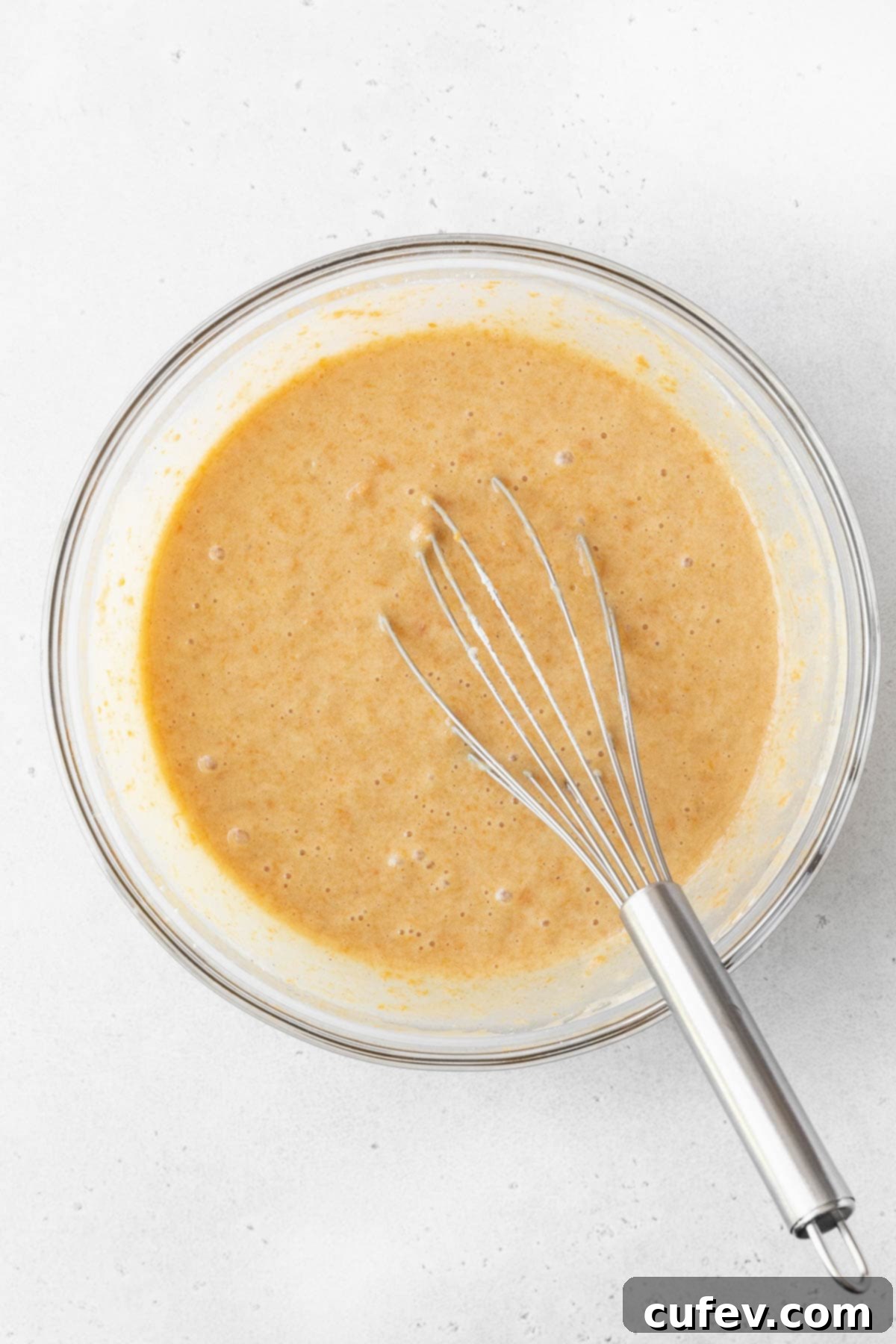
Step 5: Bake the Cake. Carefully pour the prepared sweet potato cake batter into your greased and parchment-lined loaf pan. Transfer the pan to the preheated oven and bake for approximately 60-65 minutes. The precise baking time can vary slightly depending on your oven, so keep an eye on it. The cake is ready when a wooden toothpick or a thin skewer inserted into the very center comes out clean or with only a few moist crumbs attached. Avoid opening the oven door too frequently during the first 40 minutes of baking to prevent the cake from sinking.
Step 6: Cool the Cake. Once baked to perfection, remove the sweet potato cake from the oven. Let the cake cool in its pan for about 30 minutes to an hour, or until it’s cool enough to handle comfortably. This allows the cake to set and firm up before moving. Then, using the parchment paper overhang, gently lift the cake out of the pan and transfer it to a wire rack to cool completely. It’s essential for the cake to be thoroughly cooled before frosting, as warm cake will cause your beautiful cashew frosting to melt.

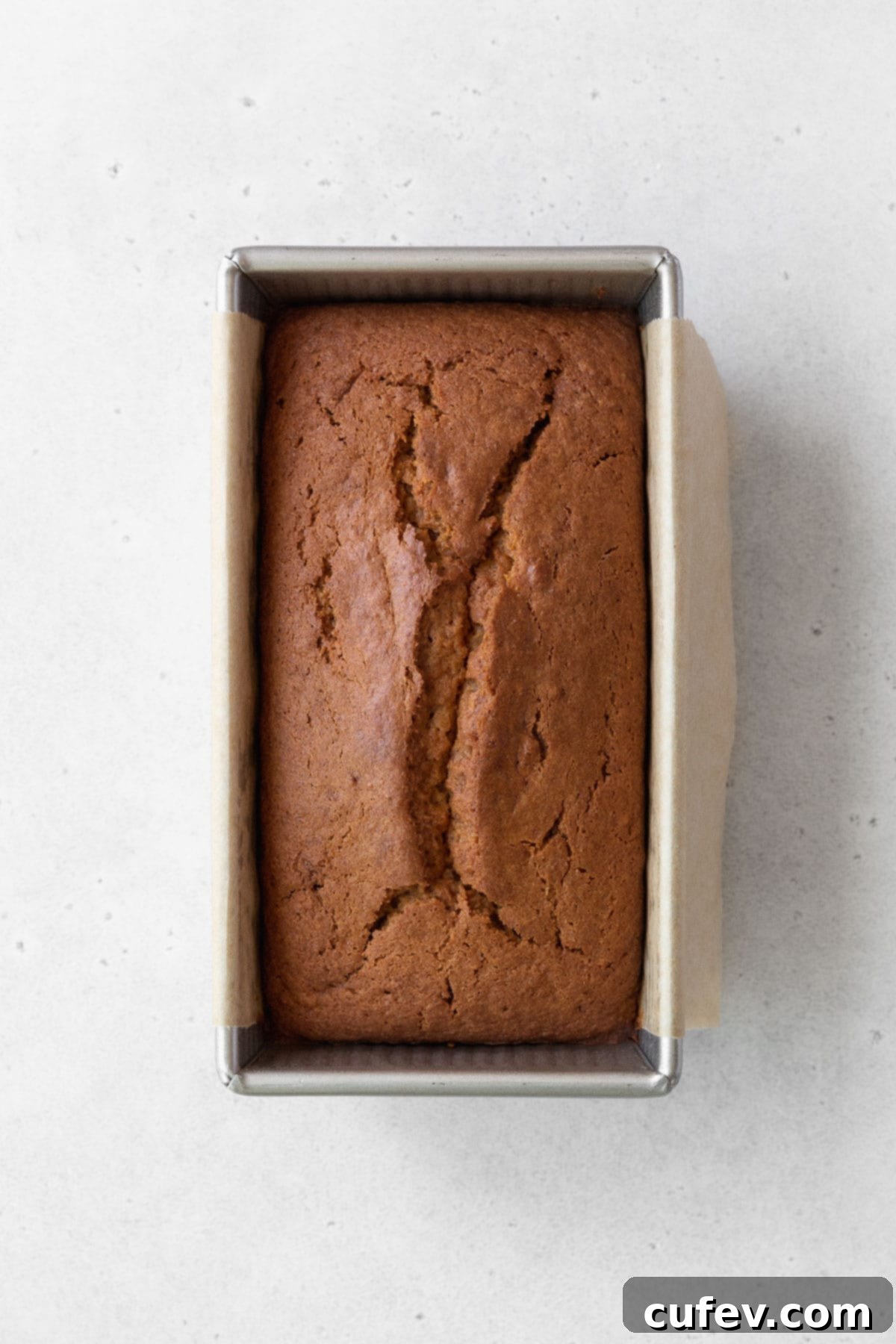
Expert Cake Baking Tips for Success
Achieving a perfectly moist and tender sweet potato cake is simple with a few helpful techniques. Here are my top baking tips to ensure your cake turns out flawlessly every time:
- Accurate Flour Measurement is Key. The most precise way to measure flour is by weight using a kitchen scale. Scooping flour directly with a measuring cup can unintentionally compact it, adding up to 20% more flour than required, which often results in a dense and heavy cake. If you don’t own a kitchen scale, the next best method is the “spoon and level” technique: lightly spoon the flour into your measuring cup until it’s overflowing, then use a straight edge (like the back of a knife) to level off the excess. This prevents over-packing the flour.
- Mastering Sweet Potato Purée. While canned sweet potato purée can be used in a pinch for convenience, making your own roasted sweet potato purée will undoubtedly add an unparalleled depth of flavor and richness to your cake. To prepare fresh purée, wash your sweet potatoes thoroughly, then wrap each one tightly in aluminum foil. Roast them in an oven preheated to 425°F (220°C) for approximately 60 to 70 minutes, or until they are completely soft when pierced with a fork. Once cooled slightly, the flesh can be easily scooped out and mashed or blended until smooth.
- Don’t Skip the Parchment Paper. One of the most common baking frustrations is a cake sticking to the pan! To avoid this heartbreak, always grease your loaf pan thoroughly, and then line it with a strip of parchment paper that extends over the sides. This creates a convenient “sling” that allows you to effortlessly lift the baked sweet potato cake right out of the pan once it has cooled slightly. It’s a small step that makes a huge difference in the ease of removal and presentation.
- Ensure Ingredients Are at Room Temperature. For optimal blending and emulsification, it’s best if your wet ingredients, especially the egg and non-dairy milk, are at room temperature. This helps create a smooth, lump-free batter and ensures even baking. If you forget to take them out ahead of time, you can quickly warm eggs in a bowl of warm water for a few minutes, and milk can be gently warmed in the microwave for a few seconds.

Crafting the Perfect Maple Cashew Frosting
This dairy-free maple cashew buttercream frosting might require a little chill time, but its creation is incredibly simple and yields a remarkably luscious result. Here’s how to whip it up:
Step 1: Blend All Ingredients Until Smooth. In a medium-sized bowl, combine all the cashew frosting ingredients: cashew butter, refined coconut oil, coconut cream, maple syrup, vanilla extract, and fine sea salt. Using a hand mixer, stand mixer, or even a sturdy whisk, mix thoroughly until the mixture is completely smooth and creamy. Ensure there are no lumps of cashew butter and all ingredients are fully incorporated. The consistency might be quite soft at this stage, which is perfectly normal.
Step 2: Chill and Whip for Fluffy Perfection. Once the ingredients are smoothly combined, cover the bowl and place it in the freezer for precisely 30 minutes. This chilling period is crucial as it allows the coconut oil and cashew butter to firm up, giving the frosting its structure. After 30 minutes, remove the bowl from the freezer. Now, using a hand mixer or a whisk, whip the mixture vigorously. You’ll notice it transforms into a lighter, fluffier, and spreadable frosting. If, after whipping, it still seems too loose or soft, simply return it to the freezer for another 10-15 minutes, then whip again. The goal is a firm yet creamy consistency that holds its shape for frosting.
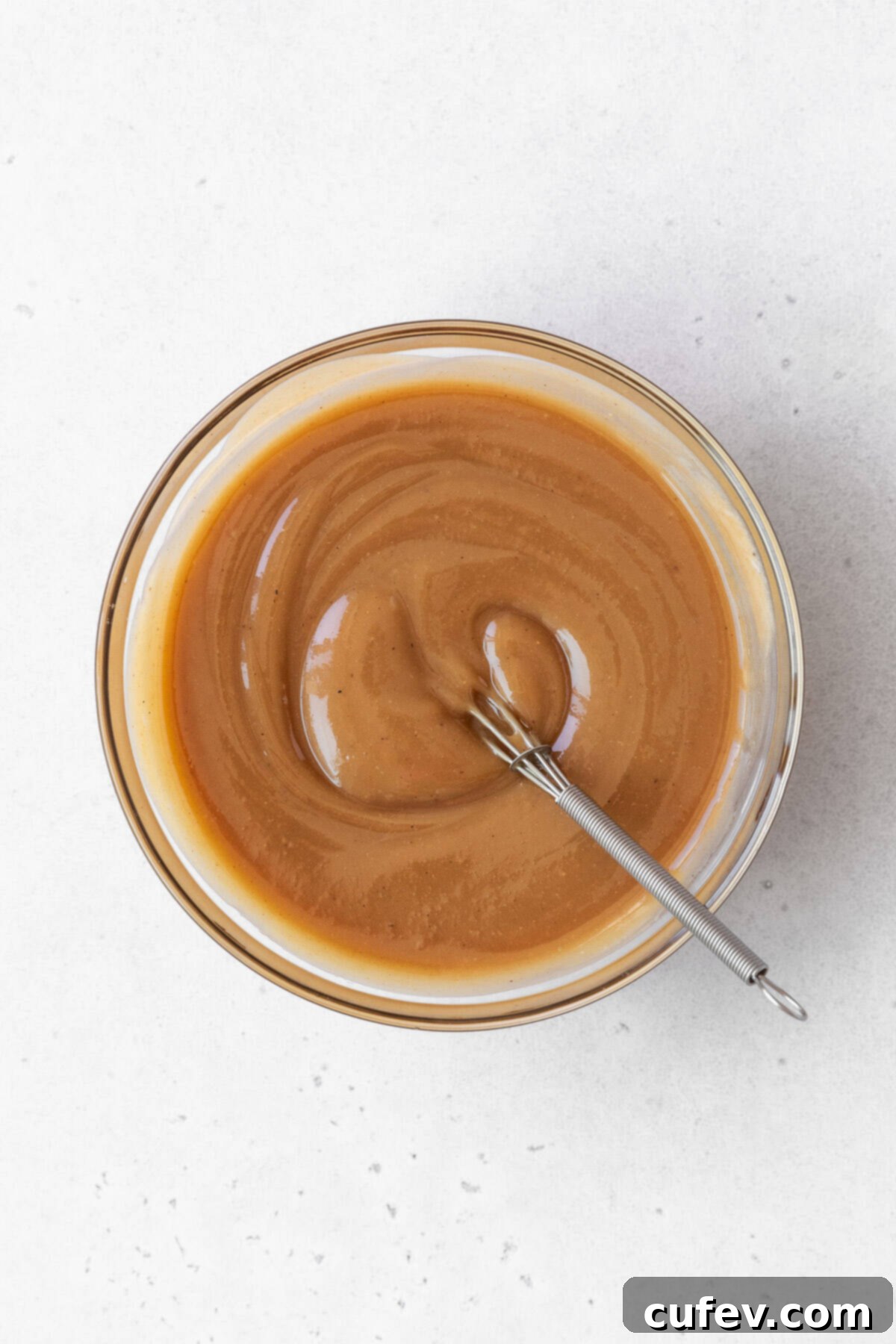
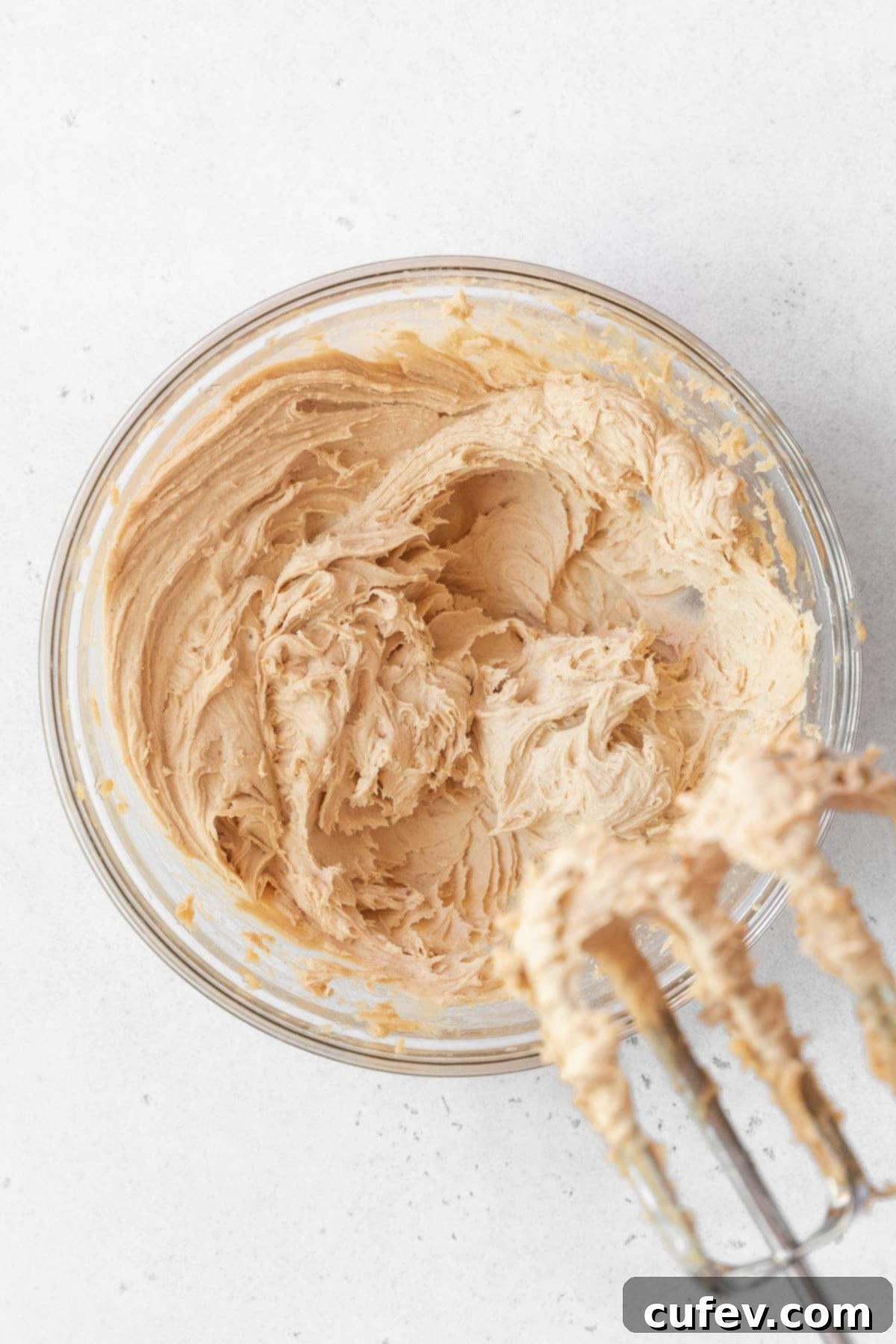
Frosting & Assembling Your Sweet Potato Cake
Once your sweet potato cake is completely cooled and your maple cashew frosting is perfectly whipped, it’s time for the fun part: assembly and decoration! You have full creative control over how much or how little frosting you apply, and the technique you use to spread it.
For a rustic and charming look, simply use an offset spatula, a regular butter knife, or even the back of a spoon to spread the frosting evenly over the top surface of your sweet potato loaf. You can create beautiful swirls and peaks for added texture and visual appeal. If you’re feeling a bit more adventurous and want a decorative finish, transfer the frosting to a piping bag fitted with your favorite nozzle. This allows for more intricate designs, from simple rosettes to elegant borders, transforming your delicious cake into a work of art. Remember, the key is to apply the frosting to a *completely cooled* cake to prevent any melting!
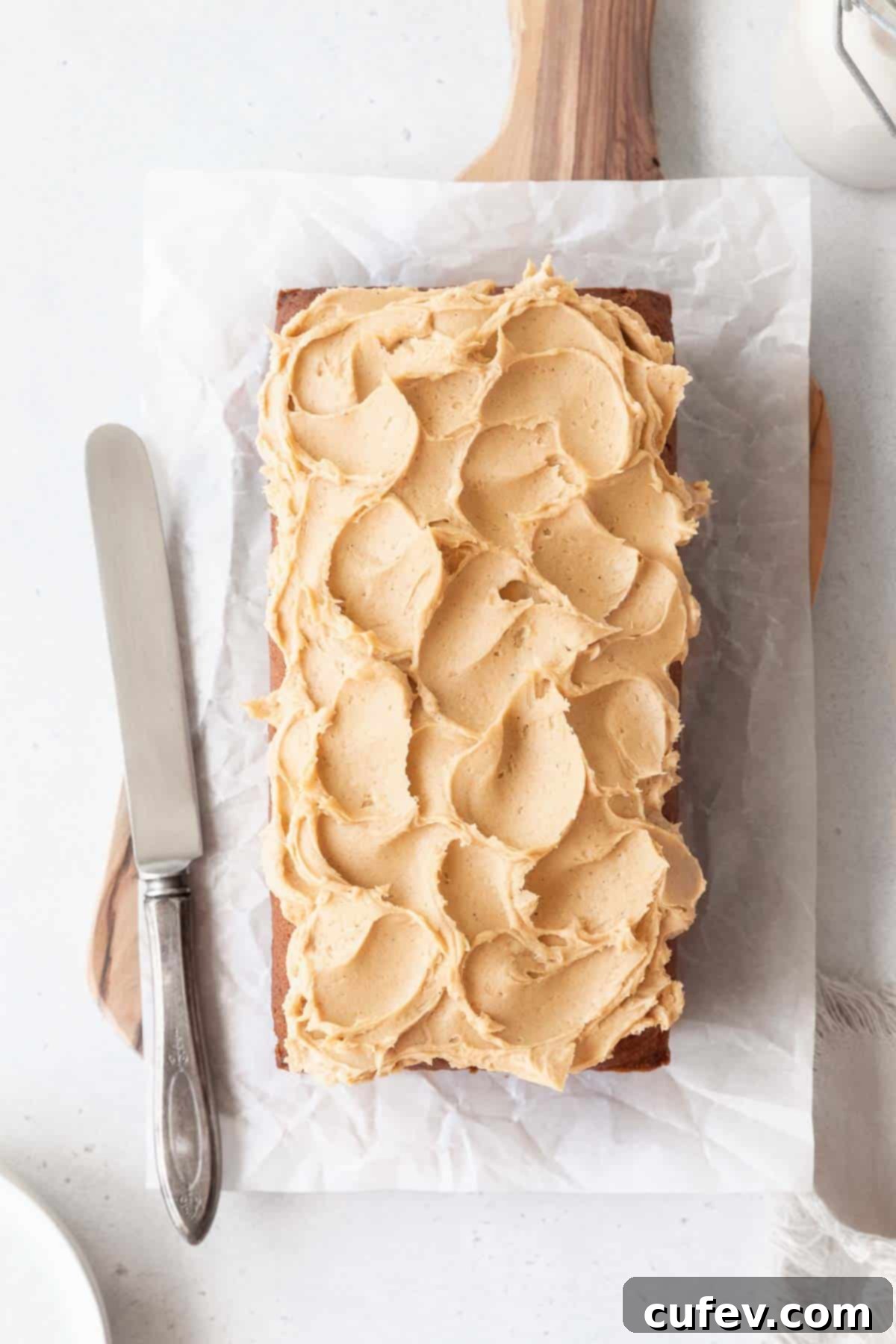
Essential Tips for Frosting Your Sweet Potato Cake
Working with dairy-free frosting can sometimes be a little different from traditional buttercreams. Here are some key tips to ensure your maple cashew frosting looks and tastes perfect, and stays stable:
- Keep the Frosting Chilled Until Ready to Use. Because this exquisite frosting doesn’t rely on powdered sugar or butter for its structure, it tends to soften and “melt” more readily as it approaches room temperature. To maintain its beautiful, spreadable consistency and prevent any unwanted drips, it’s crucial to keep your cashew frosting in the refrigerator (or even the freezer for a quick firm-up if needed) right up until the moment you’re ready to frost the completely cooled cake. This ensures maximum stability and ease of application.
- Utilize an Offset Spatula for Effortless Frosting. While some bakers prefer a straight spatula, I find an offset spatula to be an invaluable tool for decorating cakes with frosting. Its angled blade provides better clearance, allowing you to smoothly spread and swirl the frosting across the cake’s surface with greater precision and comfort. It helps create those professional-looking finishes with minimal effort.
- Always Store the Frosted Cake in the Refrigerator. To prevent the maple cashew frosting from softening or melting, especially if your kitchen is warm, it’s essential to store the entire frosted cake in the refrigerator. This not only keeps the frosting stable and looking its best but also ensures the cake remains fresh and delicious. Remove it from the fridge about 15-20 minutes before serving to allow the cake layers to soften slightly for a more tender bite, while the frosting remains perfectly set.
Exciting Sweet Potato Cake Recipe Variations
This healthy sweet potato dessert cake is absolutely phenomenal as is, but it also serves as a fantastic canvas for your creativity! Feel free to customize it with any of the following delightful variations to make it uniquely your own:
- Indulgent Chocolate Chips: For the chocolate lovers in your life, stir in ½ cup of mini chocolate chips into the cake batter just before baking. The melty pockets of chocolate will add a rich, sweet contrast to the warm spices and earthy sweet potato, creating an irresistible treat.
- Crunchy Candied Nuts: Elevate the texture and flavor of this beautiful cake by topping it with a generous sprinkle of candied cashews, walnuts, or pecans. The sweet crunch of the nuts provides a wonderful counterpoint to the soft cake and creamy frosting, adding an extra layer of sophistication and deliciousness. You can make your own candied nuts or find them pre-made.
- Sweet & Chewy Raisins: Much like the beloved addition of raisins to carrot cake, stirring ½ cup of plump, dried raisins into the sweet potato cake batter introduces delightful bursts of natural sweetness and a satisfying chewiness. They rehydrate during baking, adding moisture and a classic, comforting flavor that pairs wonderfully with the autumn spices.
- Coconut Flakes: For an added touch of sweetness and texture, consider folding in ½ cup of shredded or flaked coconut into the batter. This will complement the coconut cream in the frosting beautifully and add a delightful chew to each slice.
- Ginger Twist: Enhance the warm spice profile by adding ½ teaspoon of ground ginger to the dry ingredients. Ginger pairs exceptionally well with sweet potato and the other fall spices, giving the cake an extra cozy kick.
Delightful Serving Suggestions
This healthy sweet potato cake recipe is a truly versatile dessert that can be enjoyed in many ways. I particularly love serving it with a steaming hot cup of freshly brewed coffee, which provides a lovely contrast to the cake’s sweetness and spice. A fragrant chai latte is another excellent pairing, complementing the warm spices in the cake beautifully. For an extra touch of indulgence, add a scoop of creamy dairy-free vanilla ice cream on the side (though, of course, traditional vanilla ice cream works equally well if dairy isn’t an issue for you!). The cool, melting ice cream creates a delightful textural and temperature contrast with the moist cake.

Dietary Adaptations for Sweet Potato Cake
One of the many wonderful aspects of this sweet potato cake is how easily it can be adapted to suit various dietary needs without sacrificing flavor or texture:
- Making it Gluten-Free: This recipe is incredibly accommodating for gluten-free diets. To create a delicious gluten-free sweet potato cake, simply substitute the all-purpose flour with a high-quality 1-to-1 gluten-free flour blend. It’s crucial to choose a blend that specifically states it contains xanthan gum (or add ¼ teaspoon if your blend doesn’t include it), as xanthan gum provides the necessary elasticity and structure that gluten typically offers. Once you’ve made this simple swap, follow all other recipe directions as listed, making sure to allow the batter to rest for 30 minutes to properly hydrate the flour, which helps prevent a gritty or crumbly texture.
- Naturally Dairy-Free: The cake itself is already designed to be dairy-free by using non-dairy milk and oil instead of butter. The maple cashew frosting is also dairy-free, using cashew butter, coconut oil, and coconut cream. This means the entire recipe, as written, is suitable for those avoiding dairy, making it a fantastic and worry-free dessert option.
Storage and Freezing Directions
Proper storage is key to enjoying your sweet potato cake for as long as possible. Here’s how to keep it fresh and delicious:
- Storing Leftovers: Any leftover slices of this delightful sweet potato dessert cake should be stored in an airtight container. Place the container in the refrigerator, where the cake will remain fresh and moist for up to 4 days. Storing it in the fridge is particularly important due to the delicate nature of the maple cashew frosting.
- Freezing for Later Enjoyment: This frosted sweet potato cake freezes beautifully! For best results, wrap the entire frosted cake (or individual slices) securely in plastic wrap, then place it in a freezer-safe container or a heavy-duty freezer bag. It can be stored in the freezer for up to 3 months, making it a perfect make-ahead option for future cravings or unexpected guests. When you’re ready to enjoy it, simply defrost the cake at room temperature for 3-4 hours, or until it has thawed through completely. You’ll be amazed at how well it retains its flavor and texture.
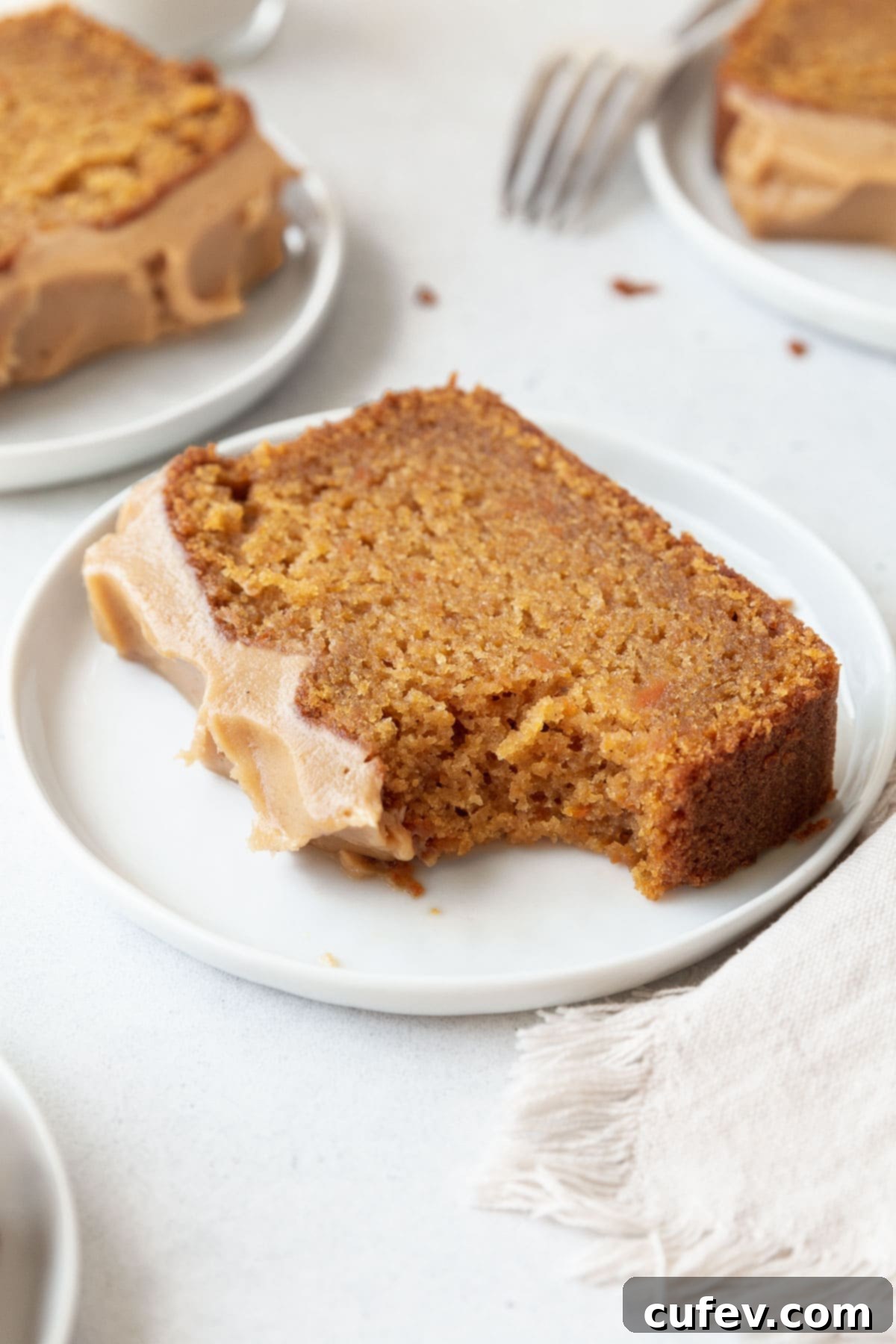
Frequently Asked Questions About Sweet Potato Cake
When you are baking whole sweet potatoes for purée, it’s generally best to peel them *after* baking. Baking the sweet potatoes whole and unpeeled helps to lock in moisture, making the flesh incredibly tender and easier to work with. Once baked and cooled slightly, the skin usually peels away effortlessly, or you can simply scoop the soft flesh out of the skin with a spoon, often eliminating the need for traditional peeling altogether. This method ensures maximum flavor and moisture for your purée.
While I am not a registered dietitian or physician and cannot offer definitive health advice, I can highlight some of the healthier aspects of this sweet potato cake recipe compared to many traditional cake recipes. This recipe is intentionally crafted to be lower in processed sweeteners, butter, and saturated fats. In fact, the luscious cashew frosting completely foregoes butter and refined sugar, relying instead on wholesome ingredients like cashew butter, pure maple syrup, refined coconut oil, and coconut cream. Sweet potatoes themselves are packed with vitamins (especially Vitamin A) and fiber. This makes it a more mindful dessert choice, offering a delicious indulgence with a more wholesome ingredient profile.
Absolutely, this sweet potato cake is an excellent candidate for make-ahead preparation, which is perfect for busy schedules or entertaining! The frosted cake holds up beautifully in the refrigerator and can be prepared 1 to 2 days in advance of when you plan to serve it. To maintain its freshness and prevent the cake from drying out, simply store the frosted cake covered in an airtight container in the fridge until it’s time to serve. This allows the flavors to meld beautifully and gives you one less thing to worry about on your special occasion.
Cashew frosting, particularly this dairy-free version, is more sensitive to temperature than traditional buttercreams made with powdered sugar and dairy butter. It’s primarily structured by the refined coconut oil and cashew butter, which soften significantly at room temperature. If your frosting melted, it’s likely because the cake wasn’t fully cooled before frosting, the kitchen was too warm, or the frosting itself hadn’t been chilled sufficiently after mixing. Always ensure your cake is completely cold, your frosting is firm from chilling, and store the finished cake in the refrigerator to keep it stable.
More Irresistible Fall Dessert Recipes to Try
If you’ve fallen in love with the comforting flavors of this sweet potato cake, you’ll be thrilled to explore more of my favorite fall-inspired dessert recipes. Each one is designed to capture the essence of autumn with wholesome ingredients and delicious results:
- This dairy-free pumpkin pie is, without a doubt, my absolute favorite Thanksgiving dessert! It’s incredibly easy to make, boasts an unbelievably silky texture, and is so rich and flavorful that no one will ever guess it’s dairy-free. If you’re vegan, make sure to try my equally delightful vegan pumpkin pie recipe instead.
- If you find yourself gravitating towards the comforting simplicity of loaf cakes, then my gluten-free pumpkin bread is a must-bake! It’s wonderfully moist, perfectly spiced with classic autumn flavors, and makes for an ideal breakfast, snack, or light dessert.
- These pumpkin blondies are pure autumnal bliss. They are wonderfully moist, delightfully fudgy, and generously studded with melty chocolate chips that create an irresistible texture and flavor combination.
- For those who love the best of both worlds, these pumpkin cheesecake brownies are the ultimate hybrid dessert! They feature a heavenly blend of creamy pumpkin cheesecake swirled into rich, decadent fudge brownies. The swirly top makes them look incredibly impressive, perfect for any gathering.
- When you’re craving a delicious dessert but don’t want to turn on the oven, try this fantastic icebox cake! It’s super easy to assemble, requires no baking, and is a fun activity to make with kids.
Thank you so much for stopping by and taking the time to discover this incredible Sweet Potato Cake recipe! I truly hope you enjoyed baking and tasting it as much as I do. For more mouth-watering dairy-free, gluten-free, and/or vegan dessert inspiration, be sure to follow me on Pinterest, Facebook, and Instagram. You can also ensure you never miss out on my newest content and delicious recipes by signing up for my email newsletter — I promise not to spam your inbox, just send tasty updates!
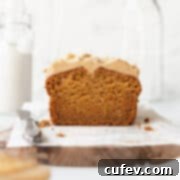
Sweet Potato Cake with Cashew Frosting
Ingredients
Sweet potato cake
- 1¼ cups all-purpose flour see Notes for gluten-free option
- ¼ cup cornstarch
- ¼ teaspoon fine salt
- ½ teaspoon baking soda
- 1 teaspoon baking powder
- ½ teaspoon ground cinnamon
- ¼ teaspoon ground nutmeg
- ⅛ teaspoon ground clove
- ⅛ teaspoon ground allspice
- ¼ teaspoon orange zest optional
- ¾ cup granulated sugar
- ¼ cup brown sugar
- ¾ cup sweet potato purée
- 1 large egg
- ½ cup oil
- 1 teaspoon apple cider vinegar
- ½ cup non-dairy milk
- 1 teaspoon vanilla extract
Cashew maple frosting
- ½ cup cashew butter
- ¼ cup refined coconut oil
- ¼ cup coconut cream
- 2 tablespoons maple syrup
- ¼ teaspoon vanilla extract
- ⅛ teaspoon fine sea salt
Instructions
Sweet potato cake
- Preheat the oven to 350°F (175°C). Grease and line an 8 inch loaf pan with parchment paper and set aside.
- In a bowl, whisk together the gluten-free flour, salt, baking soda, baking powder, spices, and orange zest (if using).
- In a separate bowl, whisk together the oil, granulated sugar, and brown sugar, making sure you have no hard clumps of brown sugar. Whisk in the egg, sweet potato purée, vanilla, and milk.
- Add the dry ingredients to the wet ingredients and stir until just combined. If using gluten-free flour, let the batter rest for 30 minutes to let the flour hydrate.
- Pour the batter into the prepared pan and bake for 60-65 minutes, or until a toothpick inserted into the center of the cake comes out clean.
- Remove the cake from the oven. Let the cake cool in the pan until cool enough to touch, about 30 minutes to an hour. Then take it out and place on a wire rack to cool completely.
Maple cashew frosting
- In a bowl, mix together all the ingredients until smooth. Cover the bowl and chill the mixture in the freezer for 30 minutes. Remove the bowl from the freezer, whip it up with a hand mixer or whisk. If it still seems loose, put it back into the freezer to chill.
- Spread the frosting on the cake. Store in the fridge to prevent the frosting from melting.
Notes
- Store: Leftover sweet potato dessert cake keeps covered in an airtight container in the fridge for up to 4 days.
- Freeze: The frosted cake can also be wrapped in plastic wrap and frozen in a freezer-safe container for up to 3 months. Defrost the cake at room temperature for 3-4 hours, or until thawed through.
- Gluten-Free: Substitute a gluten-free 1-to-1 flour blend containing xanthan gum for the all-purpose flour and follow the recipe directions as listed.
